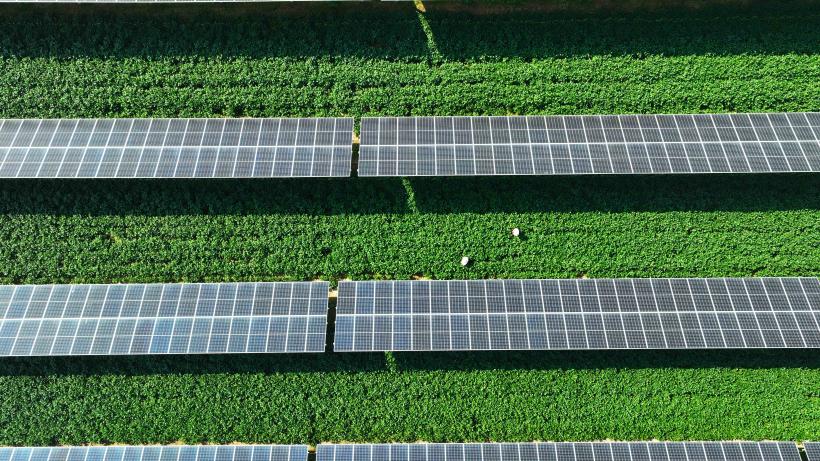
Environmental and economic impacts of agrivoltaics in Bangladesh
Agrivoltaics offer a sustainable and land-efficient approach to meeting energy needs, enhancing agricultural productivity, while providing more employment opportunities relative to other energy sources, reducing the gender employment gap, and empowering women.
Bangladesh stands at a pivotal moment in its energy trajectory. As it aims for middle-income status, the implications for its energy needs are profound. Challenges such as low per capita energy consumption, limited job opportunities, and foreign exchange reserve issues necessitate careful consideration in Bangladesh’s evolving energy landscape.
The Mujib Climate Prosperity Plan, led by the Government of Bangladesh, seeks to reshape the nation's future through sustainable development and environmental resilience, targeting a 40% share of renewable energy by 2041. As it stands, renewable energy production is approximately 1205.87 MW, representing a mere 4.12% of total energy output.
Global energy production is shifting to clean, sustainable energy sources such as solar power. They can be advantageous for densely populated and rapidly growing countries like Bangladesh. Expanding solar energy in Bangladesh, however, faces challenges due to land-intensive solar panel installation and rigid agricultural land use policies.
Agrivoltaics: a solution and a boost for overall land productivity
Exploring dual-use options on less fertile agricultural land for agrivoltaics could provide a solution, enabling both crop cultivation and renewable energy generation. The concept of agrivoltaics, introduced by Goetzberger and Zastrow in 1982 and defined by Dupraz et al. in 2011, proposes integrating food and energy production on the same land with solar panels positioned above crops to allow for the passage of agricultural machinery.
Research has shown that agrivoltaics can reduce the amount of water needed for crops by 20%, even if there's a slight decrease of 10% in crop yield or a small extension of the time it takes for crops to grow. Cultivating crops and generating solar energy simultaneously through agrivoltaics, particularly with shade-tolerant crops like garlic and onions, can reduce irrigation needs, soil erosion, and dust accumulation on solar panels. This dual land use can benefit agriculture-reliant households by optimising land productivity, meeting both food market demands and energy needs. Agrivoltaic systems have the potential to enhance overall land productivity significantly, with an increase ranging from 35% to 73%. Arid regions with ample solar radiation, alongside areas facing land constraints, are the most promising locations for installing agrivoltaics.
Studying the impacts and potential of agrivoltaics
Our study investigates the direct and upstream impacts of agrivoltaics in Bangladesh, including effects on employment, land use, water resources, greenhouse gas emissions, and co-pollutants. We compare these impacts with other energy options available in Bangladesh, such as coal, gas, oil, hydropower, nuclear, and conventional solar power, considering both direct and broader economy-wide effects.
Presenting agrivoltaics as a viable solution for Bangladesh, we aim to inform policy development, addressing concerns about low per capita energy consumption, transitioning to a middle-income status, and meeting renewable energy targets. The findings have been derived using the Input-Output (IO) method and data from the General Economic Division (GED) of the Planning Commission of Bangladesh. Our methodology encapsulates key considerations within the food–energy–environment nexus and provides policymakers a framework that clearly presents the implications of energy choices.
We find that agrivoltaics hold considerable potential in Bangladesh, particularly in employment generation, land utilisation, and wage levels when compared to alternative energy sources. By comparing agrivoltaics with established power sources such as coal, gas, oil, nuclear, wind, hydropower, and conventional solar, and examining key factors like cost, employment, land use, and emissions, it becomes evident that agrivoltaics addresses several challenges associated with renewable energy expansion in Bangladesh.
Agrivoltaics will create more employment opportunities
Agrivoltaics have the potential to create more employment opportunities per unit of power generated compared to existing energy sources. It is projected that it can create approximately 6.64 million jobs for men and 5.57 million jobs for women per year. In terms of direct employment, solar energy tends to generate fewer jobs compared to fossil fuels due to the latter's involvement in land works and construction. As most input parts for power generation are imported, conventional solar cells lack construction and earthworks leading to less direct employment. Agrivoltaics addresses this by generating employment through agriculture, one of the most labour-intensive sectors.
Reducing the gender employment gap and empowering women
Agrivoltaics is projected to have the smallest gender employment gap amongst various energy sources, with only a 16% difference between female and male employment. In contrast, the gender gap in many energy sources' employment rates is much larger, reaching 91% in the case of oil and gas. Pursuing agrivoltaics can help reduce this gender gap as agriculture is one of the main sources of employment for women. These figures reflect the formal sector, but there is significant potential for employment generation in the informal agricultural sector of Bangladesh as well. Therefore, the actual gains for women and the gender gap under agrivoltaics may be even lower than reported in this investigation.
Figure 1: Annual job input (millions/year) by gender for various energy sources
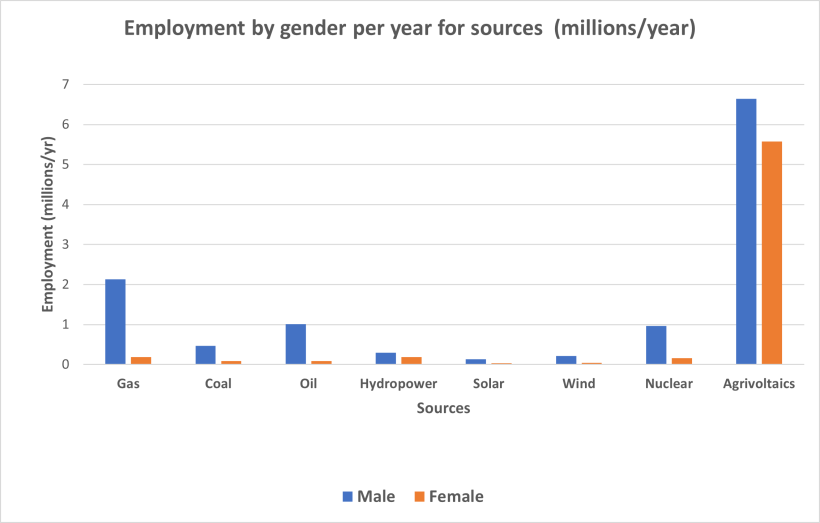
Agrivoltaics will benefit workers with fewer skills
Our results suggest that agrivoltaics will likely have a significant effect on the labour market, especially for low- and middle-skilled workers. It is estimated that it will generate jobs for 2.12 million low-skilled and 0.88 million medium-skilled workers every year. On the other hand, 1.37 million low-skilled workers and 0.58 million medium-skilled workers are expected to be employed by gas, the second largest contributor. Agrivoltaics will continue to employ 0.035 million highly skilled individuals per year, in line with other energy sources.
Figure 2: Annual job input by skill levels (millions/year) for various energy sources
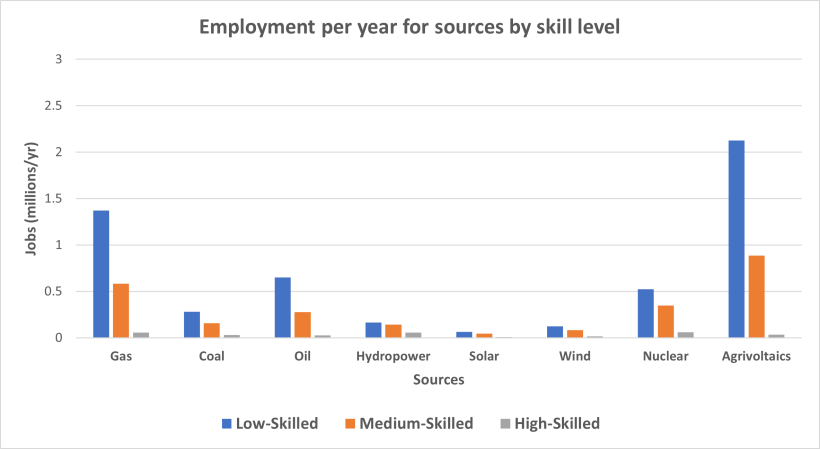
Comparative average wage levels across energy sectors
Our study illustrates that the nuclear sector commands the highest average wage level at US$ 3.5 million per year, closely followed by gas. Agrivoltaics ranks third with an average wage level of US$ 1.6 million per year. Despite slightly lower figures, agrivoltaics presents significant economic opportunities, signaling its potential for robust employment and income generation. Gains in agriculture accounted for 90% of the reduction in poverty between 2005 and 2010. Agrivoltaics could therefore reduce the increasing income inequality in Bangladesh.
Figure 3: Wage level input for various energy sources (US$/year)
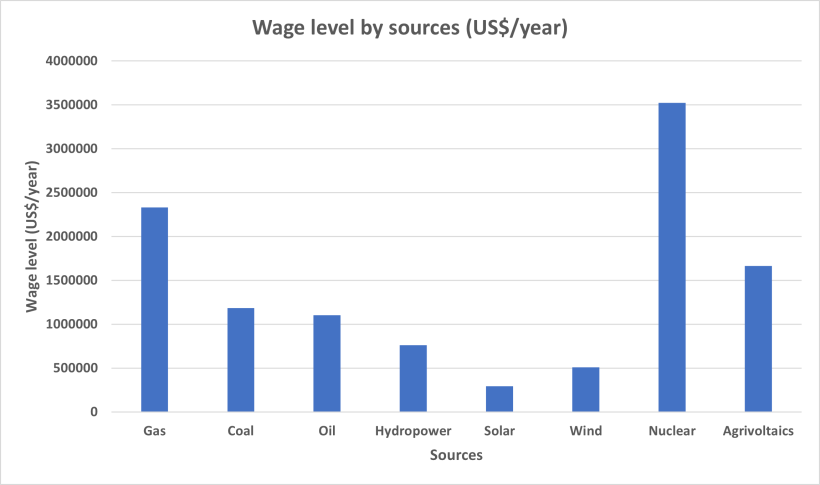
Land efficiency in energy production
Though direct land use shows solar to be more land intensive than fossil fuels, we see that it is no longer true when factoring in the upstream impacts. In considering the total land needed for energy production including inputs, agrivoltaics emerges as a notably efficient option, with projections indicating a relatively low requirement of 4850 hectares annually. In contrast, the oil and gas sectors are poised to exhibit the highest land demands, with estimates soaring to 3.15 million hectares per year and 1.5 million hectares per year respectively. This finding underscores the significant environmental footprint associated with traditional fossil fuel extraction, and the potential of agrivoltaics to offer a more sustainable and land-efficient approach to meeting energy needs.
Figure 4: Land input for various energy sources (ha/year)
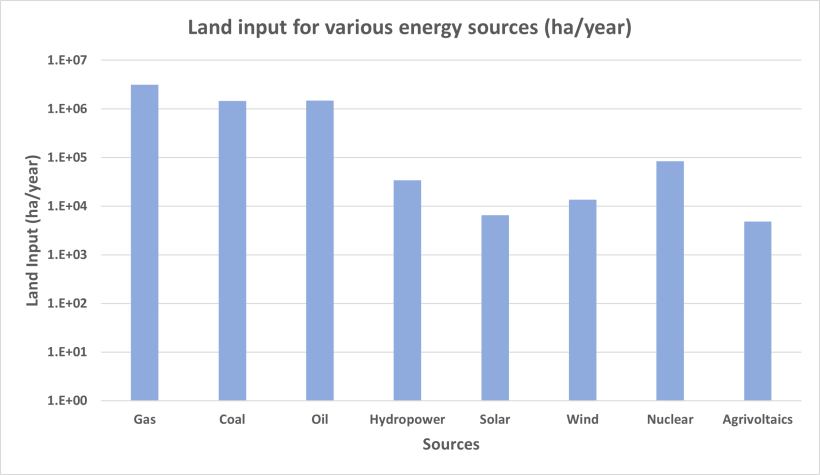
Embracing agrivoltaics can pave the way for a greener and more prosperous future for Bangladesh. With its potential to simultaneously enhance agricultural productivity and renewable energy output, agrivoltaics is poised to play a crucial role in driving sustainable development and economic growth in Bangladesh. Our study shows that transition to renewable energy could also accommodate those who stand to lose the most in large-scale transitions. The expansion of work opportunities for women, as well as low- and middle-skill workers through agrivoltaics expansion is a crucial factor in just transitions.

